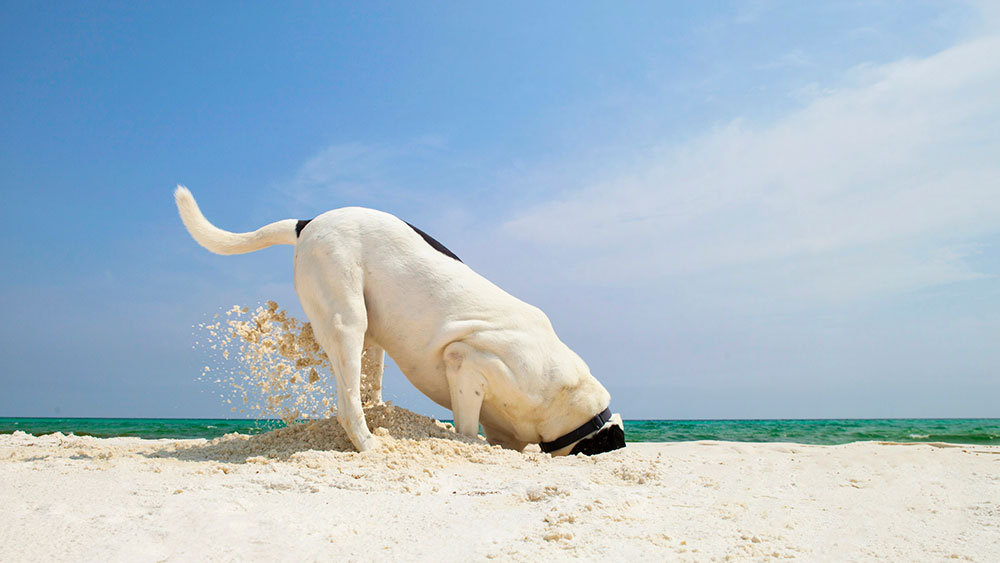Pet beach safety
Keep your pet safe from these hidden dangers at the beach.

While your furry friend may love frolicking in the sand and surf, it’s up to you to keep your dog safe from the hidden dangers at the beach.
AWLQ rehoming partner PETstock vet Dr Rachel Chang has revealed what to look out for on your day at the beach.
Jellyfish
“Dogs can be stung by jellyfish by stepping on them or biting them, usually out of curiosity,” Dr Chang said.
“Poisonous jellyfish stings can cause swelling of the head and face, wobbliness, hives, drooling and anaphylactic reactions.
“If you notice these signs, you should take your dog to a veterinarian immediately.”
Snakes
“Pet owners should always be on the lookout for snakes, which like to sunbathe on warm days, particularly on warm rocks,” Dr Chang said.
“An inquisitive dog may get bitten, so keep an eye on your buddy and monitor them for signs of a snake bite – lethargy, wobbliness, drooling and vomiting.”
Paralysis ticks
“The paralysis tick is found along the eastern coast from Cooktown in Queensland to Lakes Entrance in Victoria,” Dr Chang said.
“As the name suggests, this tick causes paralysis starting from the hind legs, then spreading to the front legs.
“If you are travelling to these coastal areas in spring and summer, we strongly recommend that you use appropriate tick protection.
Fishing equipment
“Pet owners also need to be careful of baits and other objects lying around,” Dr Chang said.
“Many dogs are inclined to chew or swallow things like bait or fishhooks because they smell fishy.
“In some cases, this can cause diarrhoea and vomiting. In more severe cases, the object may need to be surgically removed.”
Sun
“Heat stroke is another risk on warm days, particularly with energetic dogs, and happens when the dog’s body temperature gets too high,” Dr Chang said.
“This is caused by a combination of hot weather, high-energy activities such as running and sometimes dehydration.
“Signs of heat stroke include heavy panting, vomiting and lethargy.
“In severe cases, dogs can seem dazed and appear to lose consciousness.
“This can be a life-threatening emergency – if you think your dog has heat stroke, pour water over them and offer them water to drink, then get straight into the car with the air conditioner on maximum and take them straight to the vet.
“Do not wrap your dog in a wet towel as this may make them even warmer.
“To reduce the risk of heat stroke, avoid visiting the beach in the hottest part of the day – mornings or late afternoons are best.”
Related topics
Things to note
The information in this article has been prepared for general information purposes only and is not intended as legal advice or specific advice to any particular person. Any advice contained in the document is general advice, not intended as legal advice or professional advice and does not take into account any person’s particular circumstances. Before acting on anything based on this advice you should consider its appropriateness to you, having regard to your objectives and needs.
Insurance Products (excluding Travel Insurance) are issued by RACQ Insurance Limited ABN 50 009 704 152 (RACQI) and arranged by its agent, RACQ Distribution Services Pty Ltd (RDS) ABN 35 116 361 650, AFSL 567130 and RDS' authorised representatives (including RACQ Operations Pty Ltd ABN 80 009 663 414, AR No. 234978 (RACQO). Conditions, limits and exclusions apply. RDS and RACQO are in the RACQ group of companies. One of the companies in the RACQ group of companies has a minority shareholding in RACQI.
RDS and RACQO have not taken your personal objectives, circumstances or needs into account when preparing advice regarding insurance products and you will need to consider whether the advice is appropriate for you. Read the Product Disclosure Statement (PDS) and any applicable Supplementary PDS before making a purchase decision on this product. You can also access our Target Market Determinations on this website. RDS receives a commission from RACQI for the policies it arranges. RACQO receives fees paid for services it provides to RDS. Further details about remuneration are available on request prior to purchasing.
Banking and loan products issued by Members Banking Group Limited ABN 83 087 651 054 AFSL/Australian credit licence 241195 trading as RACQ Bank. Terms, conditions, fees, charges and lending policies apply. This is general advice only and may not be right for you. This information does not take your personal objectives, circumstances or needs into account. Read the disclosure documents for your selected product or service, including the Financial Services Guide and the Terms and Conditions, and consider if appropriate for you before deciding.
Except for RACQ Bank, any RACQ entity referred to on this page is not an authorised deposit-taking institution for the purposes of the Banking Act 1959 (Cth). That entity’s obligations do not represent deposits or other liabilities of RACQ Bank. RACQ Bank does not guarantee or otherwise provide assurance in respect of the obligations of that entity, unless noted otherwise.
RACQ Bank subscribes to the Customer Owned Banking Code of Practice which establishes higher standards than the law requires. The Code reflects modern consumer expectations and developments in approaches to issues such as consumer vulnerability, guarantors, and supporting customers through financial hardship. Please read our Customer Owned Banking Code of Practice page for more information.
RACQ Operations Pty Ltd (ABN 80 009 663 414 AR 000234978) and Members Travel Group Pty Ltd (ABN 45 144 538 803 AR 000432492) are acting as an Authorised Representative of the issuer of the insurance, Tokio Marine & Nichido Fire Insurance Co., Ltd. (ABN 80 000 438 291 AFSL 246 548). Any advice set out above is general in nature only, and does not take into account your objectives, financial situation or needs. Before purchasing any travel products, please consider the RACQ Travel Insurance Product Disclosure Statement (PDS) and the Target Market Determinations (TMDs) that apply to these products. Whilst the PDS outlines the Terms and Conditions of these products, the TMDs outline the intended class of customers that comprise the target market for these travel products. This will allow you to consider which products best suit your objectives, financial situation and needs and consider the products appropriateness to your personal circumstances. TMDs also outline matters involving the distribution and the review of these products. The PDS, Supplementary PDS and TMDs for each travel product can be found here.
